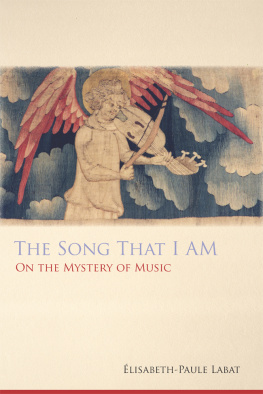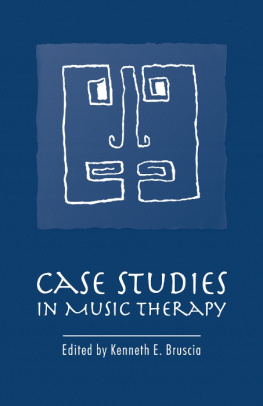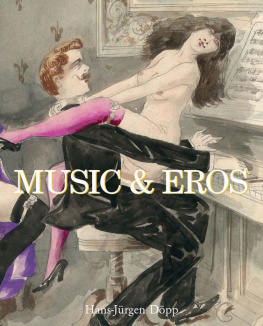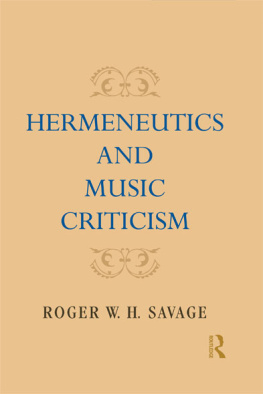MONASTIC WISDOM SERIES
Simeon Leiva, OCSO, General Editor
| Advisory Board |
| Michael Casey, OCSO | Terrence Kardong, OSB |
| Lawrence S. Cunningham | Kathleen Norris |
| Patrick Hart, OCSO | Miriam Pollard, OCSO |
| Robert Heller | Bonnie Thurston |
A Cistercian Publications title published by Liturgical Press
Cistercian Publications
Editorial Offices
161 Grosvenor Street
Athens, Ohio 45701
www.cistercianpublications.org
This work was orginally published as Essai sur le mystre de la musique (Paris: ditions Fleurus [Mayenne, impr. Floch], 1963). The English translation is done by permission of the abbey of Saint-Michel de Kergonan.
2014 by Order of Saint Benedict, Collegeville, Minnesota. All rights reserved. No part of this book may be reproduced in any form, by print, microfilm, microfiche, mechanical recording, photocopying, translation, or by any other means, known or yet unknown, for any purpose except brief quotations in reviews, without the previous written permission of Liturgical Press, Saint Johns Abbey, PO Box 7500, Collegeville, Minnesota 56321-7500. Printed in the United States of America.
The Library of Congress has cataloged the printed edition as follows:
Library of Congress Cataloging-in-Publication Data
Labat, lisabeth-Paule, author.
The song that I am : on the mystery of music / an essay by Elisabeth-Paule Labat ; translated by Erik Varden.
pages cm. (Monastic wisdom series ; no. 40)
ISBN 978-0-87907-060-1 ISBN 978-0-87907-680-1 (ebook)
1. MusicReligious aspects. 2. MusicPhilosophy and aesthetics. I. Varden, Erik, translator. II. Title.
ML3921.L33 2014
Contents
SEDI SAPIENTI
OMNIS HARMONI MAGISTR
VIRGINI MARI
HOC AMANTER DICATUR
Translators Preface
IN CAPRICCIO, HIS FINAL OPERA, Richard Strauss presented a sophisticated reflection on a problem that has exercised composers since the end of the Renaissance: how can one define the relationship between music and speech, logos and melos? It was Stefan Zweig who had prompted the composer to address this issue musically, having discovered a precedent in Antonio Salieris 1786 operetta Prima la musica, poi le parole. Being Jewish, Zweig was prohibited from publishing work in post-Anschluss Austria. Strauss, however, found a collaborator in Clemens Krauss, who composed the libretto for Capriccio, presented as a conversation piece for music in one act.
In a setting that cleverly mixes allegory and earthy realism, we follow two suitors, the poet Olivier and the composer Flamand, as they woo Madeleine, the lovely Countess, with a joint declaration of love: a poem written by one and set to music by the other. Madeleine is invited to choose him whose statement is truest and most essential. Music or poetry? Olivier or Flamand? She will decide, we are told, and the colorful cast assist Madeleine with more or less helpful advice. The cry of pain preceded speech! exclaims Flamand, only to hear Olivier retort, Yet only speech can give pain meaning. The Countess remains torn. She sees that her two suitors complement one another; each on his own seems incomplete. What one of them did not suspect is brought out by the other, says she, sensing a need for both in order to satisfy the requirements of a heart yearning for beauty.
The drama of Capriccio may strike us as agreeable but useless drawing-room chatter, designed to show off overwrought sensibilities. What is more, if we approach the problem it raises from a Christian, biblical viewpoint, the entire to-do is likely to seem superfluous. For, surely, it is beyond doubt that the Word was in the beginning? So staunch is our adherence to this Johannine dictum that the rebuke of Edwin Muirs poem The Incarnate One is often pertinent enough:
The Word made flesh here is made word again
A word made word in flourish and arrogant crook.
The poets words ring out as a challenge and a provocation. And in the logic of the Incarnation, can we in fact be so sure that theological truth unfailingly follows the principle of Prima le parole, that is, that words come first? This is the chief question addressed in this book by a most discerning commentator.
lisabeth-Paule Labat, a Benedictine nun, was a musician of the highest caliber and a woman of enviable intellectual culture. Throughout her life she sought to grasp what might be the meaning of music. She formulated her mature reflection in what remains, perhaps, her most original work, the present Essay on the Mystery of Music. When it first came out in 1963, the book was received with delight by, among others, Hans Urs von Balthasar, who recognized in it a Teresian flight of the spirit. It is, however, a dense and, to be frank, a difficult work. That is why it has seemed desirable to offer a synoptic analysis of its argument and scope by way of introduction. I shall begin with an outline of Labats biography, which has a clear bearing on her work. Second, I shall expound the central concern of the Essay, namely, the status of music as language. Is it realistic to maintain that music speaks to us? And if so, to what in us does it speak? These questions do not of themselves presuppose faith, and they are treated at first in absolute, neutral terms. Labat goes on, though, to expound them theologically, and this development will take up the third part of my introduction. Finally, in a fourth section, I shall consider the Essay as evidencing a peculiarly monastic theology; or better, as orchestrating a monastic testimony. My purpose throughout will be to show how the monastic, contemplative life can facilitate a fruitful dialogue between cultures when the insights of a venerable spiritual tradition are brought to bear on phenomena cultivated in contemporary spheres that it would be too reductive to brush aside as simply secular. Indeed, certain aspects of a self-proclaimed sacred culture may turn out to acquire new splendor from encounters with the unexpected.

Paule Labat was born at Tarbes in 1897 into a family of artists and intellectuals. A conventionally religious upbringing left her unequipped to negotiate the pain of life, which soon imposed itself. An encounter with death at the age of five or six left a deep impression, consolidated a little later when a friend of her elder brothers committed suicide. A sense of duty made the little girl pray for him, and this intercession made up the spiritual discipline of her childhood. Meanwhile, she was entering an irremediable solitude, a growing sense of being a closed world from which she yearned to break out. Her intellect demanded to know what underpinned this predicament, and she sought answers in Tolstoy, Dostoyevsky, Claudeleven Renan. Here and there Paule found intimations of a presence, but one that was vague and featureless. The Bible remained a closed book, even when the discovery of Ruusbroec indicated a bridge to link experience and faith. By contrast, the language of music seemed accessible and real.
After the Great War, Paule moved to Paris and enrolled at the Schola Cantorum. There she displayed exceptional promise. Not only was she a brilliant pianist; she wrote music of beauty and originality. A career was opening, yet Paule remained dissatisfied, haunted by the fragility of life. The death of a colleague threw her into such despair that her equilibrium was under threat. It was in this frame of mind that she began the study of Gregorian chant and so discovered an aesthetic and spiritual ambiance that allowed her to breathe. She was impressed by the unsentimental character of this music, by the serenity with which it embraces realities that seem incommensurable. The Offertory









